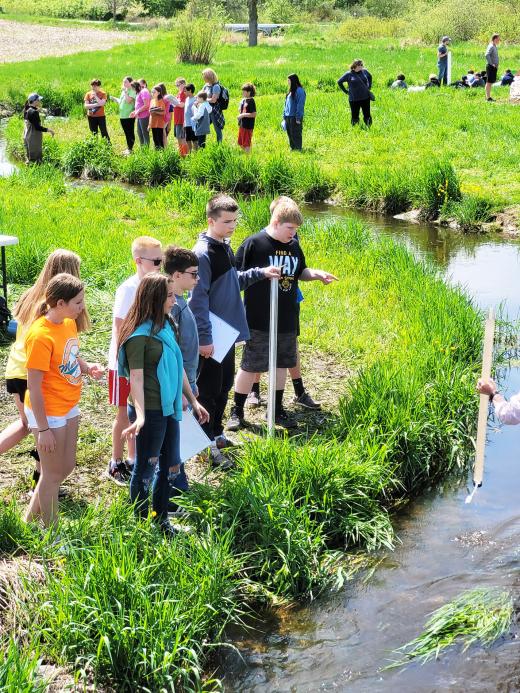Trout In The Classroom, A Students Perspective
TU’s Trout In the Classroom (TIC) program has had a tremendous impact on Stony Brook and the people of Calumet County. The program has motivated -- and continues to motivate -- landowners, Calumet County, the Lakeshore Natural Resource Partnership, Fox Valley Chapter, DNR, Fund For Lake Michigan, Natural Resource Conservation Service, local businesses and others to restore Stony Brook, the last trout stream in Calumet County Country, to a self-reproducing trout stream. And members from all these organizations gave rise to “The Friends of Stony Brook.” Check out www.friendsofstonybrook.org.
This program has impacted more than 1,000 students who have participated in raising trout in their classrooms since TIC began in the Chilton High and Middle Schools seven years ago.
Last May students once again planted trout in Stony Brook. And this year the students were asked to write about their experiences with TIC and the planting of their trout.
Below is 6th grader Katherine Lenz’s perspective on the TIC experience. I cannot wait to read Katherine’s composition when she is a senior and learn what her field of endeavor will be after experiencing TIC through high school.
Joe Bach
Fox Valley Trout Unlimited.
Trout In the Classroom
By Katherine Lenz, Chilton Middle School
The trout in the classroom project can make someone feel like a better person.
Many machines can be used in an aquarium to maintain a safe place for fish to live. Water quality testing is also crucial and ties to the nitrogen cycle to keep the fish healthy. The trout in the classroom project is an environmental recovery act and is very critical to the world. Trout release day was a truly influential day for us and the trout in the classroom project. Aquarium machines, water quality testing, environmental recovery, and trout release day all play a big part in the trout in the classroom project.
Many machines are needed to be used to maintain a good aquarium. An aerator bubbles oxygen into the fish tank, so the fish can breathe. In nature, oxygen is added to the water by flowing over rocks and falling off waterfalls. The chiller makes the water cold because trout are cold-water species. In nature, the trout are found in cold springs or streams fed by snow melt. The biological filter contains good bacteria that eat fish waste. In nature, these bacteria are found everywhere. Styrofoam is used to keep the water cold and gives the fish shade. In nature, trees can provide this. These machines are critical, but the water quality is also essential.
Water quality testing is important, and it ties to the nitrogen cycle. Ammonia is fish waste and is toxic to the fish. A bacterium called Nitrosomonas eats the ammonia and turns it into the toxic nitrite. Nitrite is still toxic, but Nitrobacter, another bacteria, eats the nitrite and turns it into nitrate. Nitrate is relatively non-toxic to the fish and once the tank has the right amount of bacteria, all the ammonia will have turned into nitrate and the tank will have fully cycled. Water quality is needed, but environmental recovery is just as critical.
Environmental recovery is very critical to the world. People have been destroying the streams where the trout live. To help fix this problem, we are growing the fish and will release them back into their stream. Just like the trout, monarch butterflies are losing their homes. To help with the situation, we are growing milkweed, the monarch’s primary food source. Deforestation is another big concern. Deforestation takes the habitat of many animals, which can lead to extinction. You can plant trees or fund a company that plants trees to slow down deforestation and slow extinction even more. One more environmental issue is plastic in the ocean. This is killing many animals that think it is food. You could maybe clean the ocean or simply recycle. Environmental recovery feels wonderful, but releasing trout into the wild will feel even better.
The trout release day was a truly important day for the fish, and we learned a lot too! The buffer is an essential part of a stream, the buffer helps purify the water. The riffle is another part of a stream where the water gets shallower and adds air to the water. Kick nets are used to catch bugs in the water. The different types of bugs can tell how good the quality of the water is. The water quality can be tested by seeing how turbid or clean the water is. Aquatic invasive species are not native animals that can harm the economy, environment, or human health. To catch the fish, people would go fly-fishing or shock the water. For fly-fishing, they have a very long line that is thicker than normal and would swat it back and forth in the water to catch the fish. By shocking the water, they shock it, so the fish are temporarily stunned, so they can scoop the fish up in a net. The trout release day was truly an amazing experience for all of us.
Aquarium machines, water quality testing, environmental recovery, and trout release day are the main parts of the trout in the classroom project. Aquarium machines are needed to keep the trout alive. Water quality testing is what tells us if the water is safe for the fish to live in. The entire trout in the classroom project is an environmental recovery act. Trout release day is the most important part of the trout in the classroom project because we are finishing off the project. These all can help to control and sustain a good ecosystem. Doing anything that consists of fixing the environment can make someone feel like a better person.
Katherine Lenz


